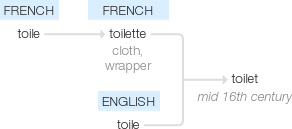Toilet
mid 16th century: from French toilette ‘cloth, wrapper’, diminutive of toile (see toile). The word originally denoted a cloth used as a wrapper for clothes; then (in the 17th century) a cloth cover for a dressing table, the articles used in dressing, and the process of dressing, later also of washing oneself (toilet (sense 2 of the noun)). In the 19th century the word came to denote a dressing room, and, in the US, one with washing facilities; hence, a lavatory (early 20th century).
wiktionary
From Middle French toilette(“ small cloth”), diminutive of toile(“ cloth”), from their use to protect clothing while shaving or arranging hair. From its use as a private room, toilet came to refer euphemistically to lavatories and then to its fixtures, beginning in the United States in the late 19th century. [1]
etymonline
toilet (n.)
1530s, earliest in English in an obsolete sense "cover or bag for clothes," from French toilette "a cloth; a bag for clothes," diminutive of toile "cloth, net" (see toil (n.2)). Toilet acquired an association with upper class dressing by 18c., through the specific sense "a fine cloth cover on the dressing table for the articles spread upon it;" thence "the articles, collectively, used in dressing" (mirror, bottles, brushes, combs, etc.). Subsequent sense evolution in English (mostly following French uses) is to "act or process of dressing," especially the dressing and powdering of the hair (1680s); then "a dressing room" (1819), especially one with a lavatory attached; then "lavatory or porcelain plumbing fixture" (1895), an American euphemistic use.
Toilet paper is attested from 1884 (the Middle English equivalent was arse-wisp). Toilet training is recorded from 1940.
